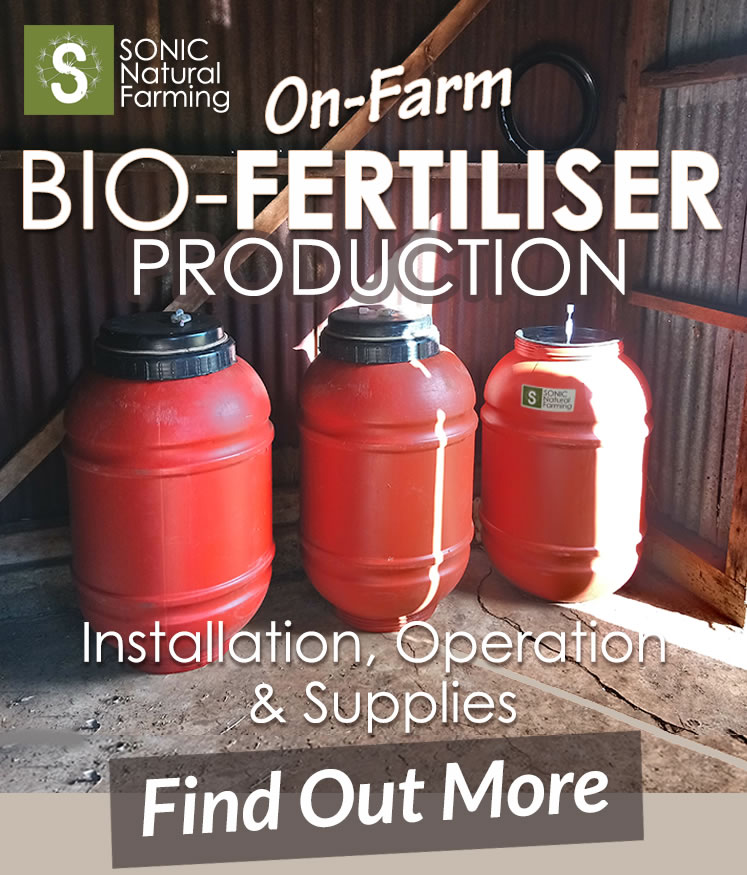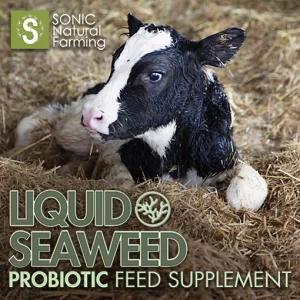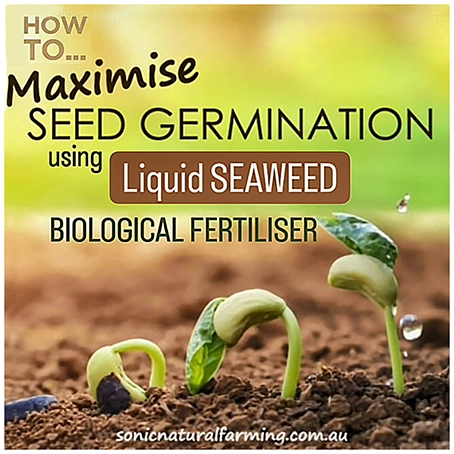What Is Seaweed Biofertiliser?
Seaweed biofertiliser is a naturally fermented liquid fertiliser and soil conditioner made from Australian bull kelp—a fast-growing marine plant rich in essential minerals, trace elements, and natural growth hormones.
Unlike synthetic fertiliser, seaweed biofertiliser works with nature, supporting soil biology and plant health in line with regenerative agriculture principles.
Used widely across Australia, this eco-friendly input enhances plant resilience, stimulates root development, and improves nutrient uptake—without disrupting the balance of soil ecosystems.
Seaweed Biofertiliser’s microbial content helps build healthy, living soils, a key focus for farmers aiming to increase long-term productivity and sustainability
In this article, we’ll look at how seaweed biofertiliser can be applied across a range of farming systems—from mixed cropping to pastures, orchards, and even livestock production.
Primary Uses of Seaweed Biofertiliser in Australia
Seaweed biofertiliser, often made from liquid kelp, is highly versatile and widely used across Australian farms. Not only does it support plant health, but it also boosts soil biology at every growth stage. In regenerative systems, farmers apply it in three main ways: as a seed inoculant; through foliar spraying; and via soil drenching.

1. Seaweed Biofertiliser for Seed Inoculation
Soaking or coating seeds with seaweed biofertiliser before planting helps boost germination rates and promotes vigorous early root development.
The naturally occurring growth hormones, like cytokinins and auxins, in kelp stimulate cellular activity in the seed, giving crops a head start
This practice is particularly beneficial in challenging soils or variable weather conditions, where a strong start is critical for success.
Boosting Germination and Early Growth
When using liquid seaweed biofertiliser, this practice becomes a cornerstone of regenerative agriculture, aligning with natural growth processes and promoting soil health.
Benefits of Seed Inoculation with Seaweed Biofertiliser
- Enhanced Germination Rates
Liquid seaweed (kelp) biofertiliser contains natural growth hormones, which stimulate seed metabolism and promote quicker and more uniform germination. - Stronger Seedlings
The amino acids and trace elements in seaweed biofertiliser support robust root development and early plant vigour, leading to healthier seedlings. - Increased Stress Resilience
Seaweed biofertiliser enhances plant immunity, enabling seedlings to better withstand environmental stresses such as drought, disease, and nutrient deficiencies. - Improved Soil Microbial Activity
Applying seaweed biofertiliser introduces beneficial microbes to the soil, fostering a healthy soil ecosystem that supports long-term plant health. - Cost-Effective and Sustainable
Biological seed treatments are an affordable alternative to synthetic inputs, reducing overall planting costs and supporting sustainable farming practices.
Application Tips for Seed Inoculation
Preparation: Use liquid seaweed biofertiliser as per the manufacturer’s instructions. For example, a common rate is 5L per tonne of seed.
Application Methods:
Spray Application: Spread seeds on a clean surface and lightly spray with the seaweed biofertiliser solution, ensuring even coverage.
Soaking: Submerge seeds in the diluted seaweed biofertiliser solution for a specified period, typically a minimum of 30 minutes to 1 hour, before planting.
Timing: Apply the seaweed biofertiliser inoculant just before planting to ensure seeds are treated at their most receptive stage.
Storage: If seeds are treated in advance, store them in a cool, dry place to maintain the efficacy of the inoculant.
By integrating liquid seaweed biofertiliser seed inoculation into your farming practices, you can promote healthier, more resilient crops. Click here to read more about seed inoculation using seaweed biofertiliser.

2. Foliar Feeding Using Liquid Seaweed Biofertiliser
Foliar feeding is one of the most effective ways to deliver nutrients directly to plants—by applying seaweed biofertiliser to the leaves, you allow for rapid absorption of key growth compounds, trace minerals, and plant hormones. This method bypasses soil limitations, making it a go-to strategy during high-demand or high-stress stages like flowering, fruiting, drought, or disease pressure.
Foliar feeding using seaweed biofertiliser bypasses soil limitations and offers immediate improvements in plant vigour
Liquid seaweed biofertiliser is naturally rich in cytokinins, auxins, gibberellins, and micronutrients that play a central role in boosting photosynthesis, stimulating natural defenses, and improving resilience to extreme weather events such as frost or heat stress.

Key Benefits of Foliar Feeding with Seaweed Biofertiliser
- Rapid Nutrient Uptake
Foliar application delivers nutrients directly into the plant’s vascular system, allowing for faster results compared to soil application—particularly when root uptake is limited due to poor soil structure or cold conditions. - Enhances Photosynthesis
As noted by John Kempf from Advancing Eco Agriculture, effective foliar applications increase photosynthetic efficiency, improving energy production and crop productivity. A well-designed foliar spray should not only correct nutrient deficiencies but also enhance the plant’s natural energy conversion. - Stress Tolerance and Recovery
Foliar feeding with seaweed biofertiliser have shown clear effectiveness in improving resilience to frost, drought, and pathogen pressure. In one study, kelp-treated crops showed no frost damage, while untreated ones experienced significant stress—a powerful real-world indicator of kelp’s protective effects. - Supports Soil Health Indirectly
Healthier, more efficient plants demand fewer soil nutrients per unit of yield, reducing nutrient mining and promoting better long-term soil stewardship—an important tenet of regenerative agriculture. - Financially Rewarding
Foliar application is one of the most cost-effective strategies in a grower’s toolkit—provided it is properly formulated and timed.
Application Tips for Foliar Spraying
Dilution & Timing:
For foliar application of liquid seaweed biofertiliser, dilute at a 1:10 ratio (1 part liquid kelp to 10 parts water) and apply under cloud cover, early morning or late afternoon to avoid evaporation and leaf burn. This timing also enhances nutrient uptake. Adjust frequency based on crop type, growth stage, and environmental stress.For full rate recommendations by crop or method, see SONIC Natural Farming’s application rates guide.
Spray Coverage:
Aim for fine misting and thorough leaf coverage—especially on the underside of leaves where stomata (nutrient entry points) are most concentrated.Compatibility:
Liquid seaweed biofertiliser mixes well with other biological inputs like fish hydrolysate, humic acids, or trace mineral blends. Jar test before mixing with other products.Frequency:
For most crops, apply every 2–3 weeks during active growth stages, and more frequently during stress periods or in early development stages.
When used as part of a regenerative farming system, liquid seaweed biofertiliser foliar feeding offers fast-acting plant nutrition and long-term benefits for crop health, resilience, and soil productivity.

3. Soil Drench or Fertigation Using Seaweed Biofertiliser
Applying seaweed biofertiliser as a soil drench or via fertigation systems is one of the most effective strategies for supporting both plant growth and soil regeneration.
Unlike surface-level fertilisers that often miss the root zone, this method targets where it matters most: the rhizosphere—the biologically rich zone around plant roots
Liquid seaweed biofertiliser contains a unique combination of trace minerals, natural plant hormones, amino acids, and microbial stimulants that not only nourish the plant but also activate microbial life and improve soil structure. These effects build cumulatively over time, making this method ideal for long-term soil health and sustainable production.

Key Benefits of Soil Drench and Fertigation with Liquid Seaweed
- Deep Root Development
Liquid seaweed biofertiliser promotes hormonal activity that encourages stronger, deeper roots, which improves drought resilience and enhances nutrient uptake. - Microbial Stimulation
Seaweed kelp feeds beneficial microbes such as bacteria and fungi, which in turn break down organic matter, fix nutrients, and create soil structure. This fosters a healthier, more active soil food web. - Improved Soil Structure and Water Retention
Regular applications help bind soil particles into aggregates, which enhance water retention and aeration—critical for both plant growth and microbial activity. - Long-Term Soil Fertility
Rather than delivering a short-term nutrient spike, seaweed biofertiliser supports the microbes that perform nutrient cycling and increases organic matter, making it ideal for regenerative systems focused on soil fertility. - Efficient, Scalable Application
When used in fertigation systems, kelp can be evenly and efficiently distributed over large areas, reducing labour costs while increasing consistency.
Application Tips: Soil Drench or Fertigation with Liquid Seaweed
Dilution & Dosage: For a soil drench, use a 1:10 dilution (1 part liquid kelp to 10 parts water), depending on crop type and stage of growth.
- Fertigation Rate: Apply 3–15 L per hectare, either with each or every second irrigation cycle, depending on crop stage and need.
- Soil Drenching: For small areas, apply 30–60 mL per 10 L of water around plant bases during early growth or after transplant.
Timing: Apply early morning, evening, or during cool, overcast weather to optimise uptake. Best applied during early growth, pre-flowering, or after transplanting to reduce shock and support establishment. Regular applications every 3–6 weeks can maintain soil and plant health.
Soil Conditions: Works especially well in low-biological activity soils, compacted areas, or where chemical residues have reduced microbial populations. Also beneficial in sandy soils needing improved water retention.
Combination with Other Inputs: Liquid seaweed biofertiliser works synergistically with compost teas, fish hydrolysate, humates, and microbial inoculants—jar test before combining.
Irrigation System Tips: Ensure filters are clean and systems are flushed regularly when using organic liquids. Use coarse nozzles or low-pressure systems for best results.
When integrated into a regenerative system, soil drenching or fertigation with liquid seaweed biofertiliser not only boosts current crop performance but helps rebuild the biological and structural integrity of your soil—laying the foundation for more resilient and long-term productive farming.
Harnessing Seaweed Biofertiliser Across Your Whole System
In regenerative farming systems across Australia, seaweed biofertiliser is proving to be one of the most versatile biological tools available. Whether it’s used as a seed inoculant, a foliar spray, or a soil drench, each method delivers unique benefits that feed soil microbes, boost plant resilience, and improve nutrient efficiency at every stage of the growing cycle.
Inoculating seeds helps establish strong early microbial partnerships. Foliar sprays enhance photosynthesis, energy production, and stress tolerance. Soil drenching supports microbial life below the surface, improving soil structure and nutrient cycling.
Together, these applications form an integrated approach to building healthier soils, more resilient crops, and more productive landscapes—naturally. As more Aussie farmers turn to biological practices, seaweed biofertiliser stands out as a simple, sustainable input that fits seamlessly into the future of regenerative agriculture.
Disclaimer:
The information in this article is for general guidance and not professional advice—always consider your individual circumstances or consult with a professional before making decisions. For more details, please review our full Disclaimer.
Unlock the potential of your land by tailoring organic fertilisers to suit your unique Aussie soil type. The right organic fertilisers—like compost, biochar, or liquid fish—can not only boost crop resilience, but also improve soil fertility and sustainability over time.
Discover some of the most popular natural organic fertilisers you can tailor to your soil. Download our ‘Organic Fertilisers by Soil Type – Quick Guide’ to get started!

Cut Fertiliser Costs By Up To 90%















